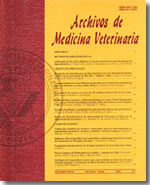Impacto de la exposición prenatal a testosterona sobre parámetros biométricos y endocrinos en ovinos recién nacidos
Contenido principal del artículo
Resumen
Se estudiaron parámetros biométricos y endocrinos de crías recién nacidas de ovejas Suffolk Down expuestas prenatalmente a un exceso de testosterona (EPT) durante 60 días (EPT-P1, n = 16) y 90 días (EPT-P2, n = 12), a partir del día 30 de preñez. Las madres control (n =32) recibieron aceite vegetal. Al momento del parto se registraron: hora del parto, número de crías por madre y sexo de las crías. Ocho horas postparto se registraron: las características de los genitales externos, distancia ano-meato urinario (DAM) y peso corporal. Se determinó concentración plasmática de cortisol, T3 y T4, por radioinmunoensayo. Hora del parto, número y sexo de las crías fue similar entre los grupos. Las hembras nacidas de madres con EPT-P1 y EPT-P2 exhibieron genitales masculinizados con presencia de un pene y un escroto vacío. Las hembras nacidas de madres EPT-P1 presentaron menor peso al nacimiento que las hembras y machos control y hembras nacidas de madres EPT-P2 (P < 0,05), DAM semejante a los machos (P<0,01) y menor concentración de T4 que los otros grupos (P<0,05). Además presentaron una relación inversa entre cortisol plasmático y peso corporal. Las hembras nacidas de madres EPT-P2, con excepción de la masculinización de los genitales, no se diferenciaron de las hembras nacidas de madres control. Los parámetros biométricos y endocrinos de los machos no mostraron diferencias entre los tres grupos. Concluimos que la EPT produce masculinización de los genitales de hembras y, dependiendo de la concentración de testosterona, la EPT puede disminuir las concentraciones plasmáticas de T4 en las hembras. La EPT no influye en parámetros biométricos y endocrinos de machos recién nacidos.

